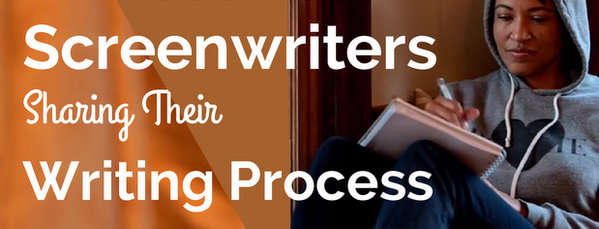Stephanie Palmer: Have you ever wanted to be a fly on the wall to hear how a successful screenwriter works through the writing process?

I’ve selected six short films (produced by Academy Originals) so you can see the writing process and inner-workings of successful screenwriters.
Not only will you see inside the offices, bedrooms, dining rooms, yoga rooms, backyards, and other spaces where these writers work, you’ll see that they still struggle each day to make incremental progress.
I hope this inspires you to stick with your writing process and possibly experiment with some new techniques.
My goal is to help you write a screenplay you can sell and learn how to pitch your ideas effectively.
See Inside The Script Writing Process
As you’ll see, there are many methods, habits, and systems that can work. I’ve chosen to focus on six specific writers, each of whom uses a different writing process.
Script Writing Process #1:
Extensive Research and Detailed Note Cards
Dustin Lance Black won the Academy Award and two WGA Awards for Best Original Screenplay for Milk. He also wrote J. Edgar, Pedro, and directed Virginia.
“I boil down the moments that I think are cinematic, the moments that I think are necessary for the story. I start to put them onto notecards. Each notecard should be as pure and singular an idea as possible because I want to be able to move all the pieces around and be able to create a film. It’s about then taking these cards and for me, over the course of weeks to months, laying them out and distilling down what is necessary to tell the story.” — Dustin Lance Black
Script Writing Process #2:
Write In Long-Hand In Notebooks
Tina Gordon Chism wrote Drumline, ATL and wrote and directed Peeples. Her thriller Inheritance was purchased by Sony and HBO is developing Crushed.
“It’s always a spark. It could be a world, it could be a character, it could be a situation, a question I might be asking myself about human behavior. That will happen in an instant, but the slow burn is the details. Some people use notecards to do this, I use notebooks. It’s something about how I’m thinking about the details when I’m writing in long-hand that makes it flesh out a little easier for me.” — Tina Gordon Chism.
Script Writing Process #3:
Write Outline On Two Sides Of A Large Sheet Of Paper
Aline Brosh McKenna wrote The Devil Wears Prada, We Bought A Zoo, 27 Dresses, I Don’t Know How She Does It, Morning Glory, Laws of Attraction, and Three To Tango.
“I can fold it up and then take it to a meeting. I can lay them out for people and sort of show them how I think the whole movie goes. I started doing that instead of cards because the cards, to me, started to feel like it was really defuse and all over the place. I started doing it more that way and it felt more organic to me.” — Aline Brosh McKenna
Script Writing Process #4:
Cycles Of Procrastination And Productivity
Mike White wrote ‘School of Rock’, ‘Nacho Libre’, ‘Orange County’, ‘The Good Girl’, and wrote and directed ‘Year of The Dog’.
“You’re impregnating your brain with an idea and it needs to gestate. Almost like I’m waiting as long as I can before I actually start writing. All that looks like, from the outside, is me sitting on the couch or watching TV or watching movies or reading books or walking around the neighborhood. I see the cycles of being really productive and then going through these periods where it just seems like I’m sitting around my house literally staring at the walls.” — Mike White
Script Writing Process #5:
Take Pictures, Notes And Send Them To Your Phone
Ava Duvernay wrote and directed ‘I Will Follow’ and ‘Middle Of Nowhere’. Duvernay won the Best Director Prize for Middle Of Nowhere at the 2012 Sundance Film Festival, making her the first African-American woman to receive the award.
“I take pictures a lot and I take a lot of notes. I find that I used to just scribble on scraps of paper but now more and more I rely on the phone. I’ll put in the subject header XO. That’s my code. Hugs and kisses to myself of inspiration. It’s so corny. But whenever I need to sit down and pull in something that I’ve seen, I search “XO.” and everything comes up.” — Ava Duvernay
Script Writing Process #6:
Feel Guilty Until Noon, Then Write
Paul Haggis wrote and directed Crash (which won Academy Awards for Best Picture and Best Original Screenplay), Third Person, and In The Valley Of Elah. Haggis also wrote Million Dollar Baby, Casino Royale, Quantum of Solace, Flags Of Our Fathers, Letters From Iwo Jima, and The Last Kiss.
“My daily routine. I do my emails and try not to write for as long as possible. Then, I start to feel guilty and so usually around noon, I’m feeling really guilty. So, I actually open the script and start to work on it. I write, I type, I write, I type. I take notes on my iPhone. At one point I had two computers so I could have notes on one and a script on the other. I just have to fool myself into thinking that this is a new process and this will work much better than the last process.” — Paul Haggis
Subscribe the Academy Originals YouTube channel and follow @TheAcademy on Twitter to see the new films when they are released.


